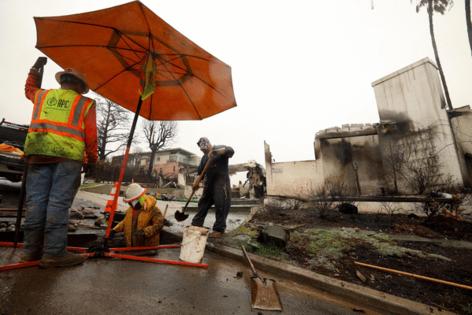Warning of 'life-threatening' debris flows as torrential rains, flash floods hit LA County
Published in Weather News
LOS ANGELES — The biggest rainstorm of the season slammed into Southern California on Thursday, bringing with it flash floods, severe thunderstorms and the possibility of “life-threatening” debris flows just a month after fierce Santa Ana winds propelled a firestorm across L.A. County.
The National Weather Service issued flash flood and thunderstorm warnings for a wide swath of the county, with rainfall rates of 0.75 inches to 1.25 inches per hour expected. Debris flows may be triggered when rainfall rates exceed 0.5 inches per hour.
“There is now a high risk for a life-threatening debris flow,” the weather service said. “Mud, rock, and debris flows will have the potential to impact drainages, roads and residences in and directly below the burn area.”
Flooding and mudslides were reported in the Hollywood Hills, Pacific Palisades and Altadena areas. Burn scars are at especially high danger of slides as intense heat from fire can create a water-repellent layer in the soil, while loss of vegetation makes soil more prone to erosion.
Flash flood warnings Thursday afternoon and evening covered a large portion of Los Angeles County, including Malibu, the San Fernando and San Gabriel valleys, the Westside, downtown L.A., Altadena, a swath of the San Gabriel Mountains, East L.A., Southeast L.A. County and Whittier. The weather service also warned of severe thunderstorms across much of L.A. County, bringing wind gusts up to 70 mph and a chance of weak tornadoes.
Earlier in the day, the rain sent a cascade of mud and water from a hillside onto Pacific Coast Highway in Malibu and trapped at least two vehicles inland. PCH will remain closed between Chautauqua Boulevard and Carbon Beach Terrace until at least 6 a.m. Friday, according to the California Department of Transportation.
Debris flows were also reported on Mulholland Drive and Outpost Drive in the Hollywood Hills and down Palisades Drive in the Pacific Palisades.
Fire crews have responded to at least two reports of vehicles trapped in rain flows — a pickup truck in the Elysian Valley and an SUV in Panorama City, according to the Los Angeles Fire Department.
And in Ventura County, the storm possibly triggered a tornado, the weather service said. A mobile home park in the Oxnard area suffered damage to mobile home roofs, carports and power lines.
On Thursday morning, Jude Bell sat in her SUV — shielded from the steady drizzle that dampened her red brick home in Altadena — making a list of what needed to be done as she waited for a contractor to arrive.
Her home on Alameda Street, unlike many others a block away, was still standing after the devastating firestorm that tore through the San Gabriel Valley community and left death and destruction in its wake.
Parts of her home were damaged by the powerful Santa Ana winds that accompanied the inferno, and the inside has a lingering smoky smell. A month after the fire, she’s still grappling with her insurance company to get things fixed, and she’s worried about toxic compounds in the soil.
Amid all this, the impending rain felt like just another hurdle. The storm wasn’t top of mind, even as experts warned the rain could unleash destructive debris flows, potentially dealing another devastating blow to the ailing community.
“Who knows?” Bell said with a hint of exhaustion. “The fire wasn’t front of mind, either. I didn’t think my house would be damaged by fire.”
Atmospheric rivers that dropped modest rain across Los Angeles County earlier this month didn’t result in significant damage. But on Thursday, the strongest storm of the winter was unleashing heavy rain across the fire zones, prompting evacuations.
In the San Gabriel Valley, where the Eaton fire charred a devastating path — leveling more than 9,400 structures including many homes and killing 17 people — a state report noted that there’s a high likelihood that heavy rain could generate large, damaging post-fire flooding and debris flows.
Early Thursday on the Westside, where the Palisades fire burned hillside communities all the way to the Pacific Ocean, officials were also preparing for rockslides, debris flows and flooding.
Customers at Ace Hardware in Altadena had been coming in to grab materials such as tarps and sandbags to protect their damaged homes from the elements.
They’d also been venting and crying, said cashier Paola Vargas, 25.
“They’re scared; we’re all a bit scared,” said Vargas, who also lives in Altadena. “First we had to evacuate because of the fire and now we’re preparing for a flood?”
Her home survived the fire but was damaged by smoke, so her family ended up throwing out much of their belongings as trash.
“I don’t think it’s ever going to be the same again,” she said. “My house is still there, but seeing many neighbors’ homes that are gone, it feels empty. It doesn’t feel the same, very quiet.”
Across Los Angeles County before the peak of the storm, sheriff’s deputies and police officers went door to door to warn residents at greatest risk of being hit by a debris flow that they should evacuate or at least prepare to leave quickly.
Mandatory evacuation orders were issued for 106 homes in Pacific Palisades, nine homes in the Sunset fire area and four homes in the Hurst fire zone, said Los Angeles Police Department Chief Jim McDonnell.
“These are mandatory evacuations, not warnings,” he said. “Residents must leave for their safety. We understand that evacuations are difficult, but this is all about keeping our community safe.”
In areas patrolled by the L.A. County Sheriff’s Department — Malibu, Altadena, San Dimas and Palmdale — 98 residences were under mandatory evacuation orders, according to sheriff’s spokesperson Nicole Nishida.
Evacuation warnings were also issued in a number of burned areas, including Brentwood, Sunset Mesa, Hollywood and Hollywood Hills West, Sylmar, Calabasas, Kinneloa Mesa, Arcadia, Sierra Madre and the San Gabriel Mountains, including Mount Baldy Village and Wrightwood.
Farther south, in Orange County, the persistent rain prompted evacuations, and Knott’s Berry Farm closed.
In the area where the Airport fire charred the hillsides above Trabuco Canyon in September, officials issued a mandatory evacuation order for the RC Airport, fire station, campground/park and school, Bell Canyon and Hot Springs Canyon.
The storm is expected to move out of the region Friday, ushering in another potentially extended period of dry weather for the rest of February.
_____
©2025 Los Angeles Times. Visit at latimes.com. Distributed by Tribune Content Agency, LLC.







Comments